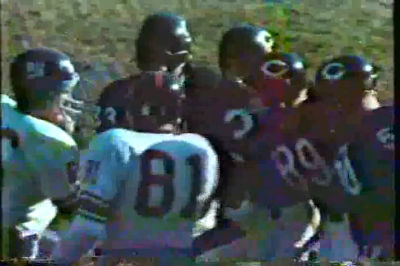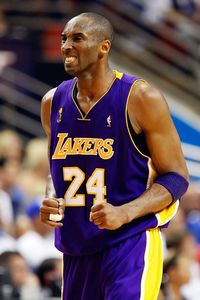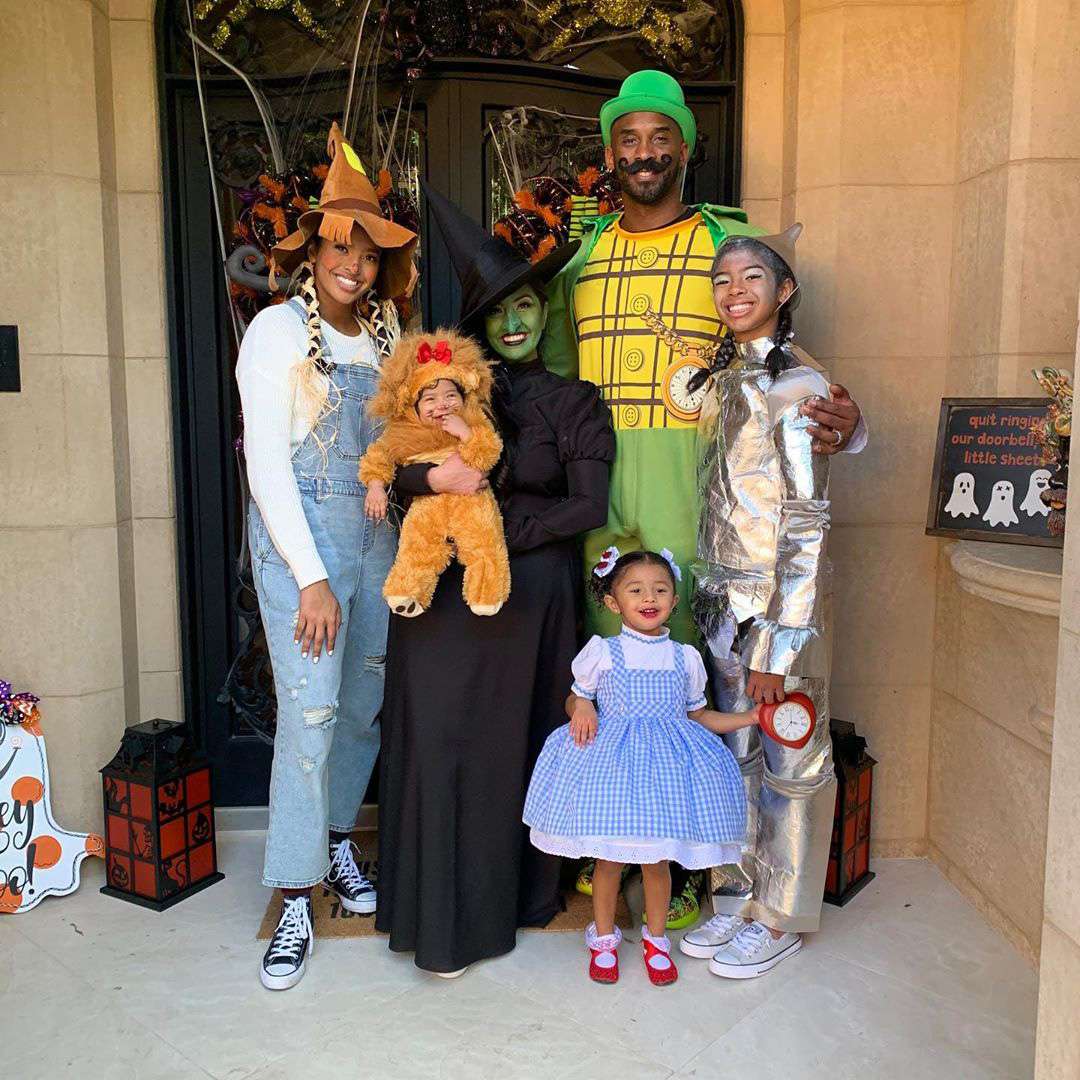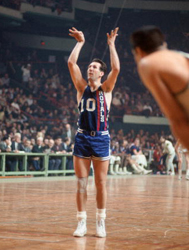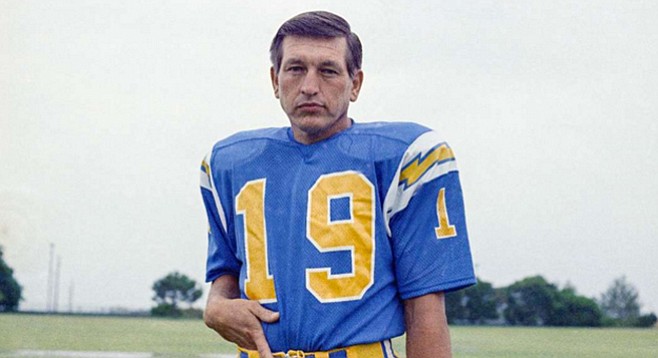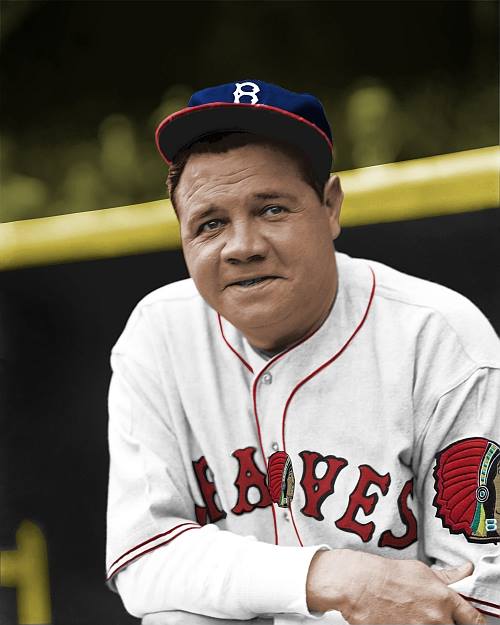Kobe Bryant wearing a Lakers "throwback" jersey, 2005...
Or is it the regular uniform of the Minneapolis Lakers on Earth-2?
In DC Comics, "The Golden Age of Superheroes" was from the 1938 debut of Superman until the 1950s. When a new version of The Flash debuted in 1956, that began "The Silver Age."
In September 1961 (the date on the cover, although it was printed and released perhaps 2 months earlier), Flash #123 was published with the story "The Flash of Two Worlds." The recently-introduced version of The Flash, a police forensic scientist named Barry Allen, who gained super-speed when a lightning bolt struck a shelf full of chemicals which then doused him, was shown meeting the Golden Age Flash, Jay Garrick, a college student who inhaled "heavy water vapors" and gained super-speed as a result.
The story was written by Gardner Fox, who created the original Flash, Garrick, in 1940. Robert Kanigher created Allen in 1956, but had no role in this particular story, which explained that the Flashes lived in parallel worlds. Eventually, DC would name them "Earth-1" (or "Earth-One"), on which Allen lived; and "Earth-2" (or "Earth-Two"), on which Garrick lived.
The story was so successful, DC brought back the other Golden Age heroes, and put them on Earth-2, showing them as older, since they had debuted in the 1930s or '40s. But there were some differences, some bigger than others:
* Superman: On Earth-1, Clark Kent was born Kal-El on Krypton, and he was still trying to prevent his Daily Planet teammate, Lois Lane, from finding out his secret identity. On Earth-2, he was born Kal-L, and Lois knew, and they were married.
* Batman: On Earth-1, Bruce Wayne and Selina Kyle, Catwoman, had a flirtatious relationship, as Catwoman played both sides, sometimes an anti-hero, sometimes a villain. (On the 1966-68 Batman TV series, she was only a villain, and yet, she and Batman had the never-resolved hots for each other.) On Earth-2, Bruce and Selina were married, and their daughter Helena Wayne became a superhero, the Huntress. She would marry Earth-2's Robin, Dick Grayson, who never became Nightwing (but did, on occasion, wear the Batman costume), while there were no other Robins (Jason Todd, Tim Drake, etc.).
* The Flash: The power in question was the same, but they didn't even live in the same city. On Earth-1, Barry Allen lived in Central City. On Earth-2, Jay Garrick lived in Keystone City. And neither man's city even existed on the other man's Earth.
* Green Lantern: On Earth-1, Hal Jordan was a test pilot who followed an alien ship's crash. The alien was a member of the Green Lantern Corps, and, as he died, handed Jordan his "power ring," telling him, "It tells me you are worthy," and Jordan becomes the Green Lantern assigned to protect the sector that includes Earth, and meets the other members of the Corps, frequently teaming up with them. His costume is green with black trim.
On Earth-2, there is only one Green Lantern, Alan Scott, a railroad engineer who finds a lantern whose backstory doesn't matter here, and he fashions a ring out of it, and his costume is multicolored. Also, Jordan wears his ring on his right hand, while Scott wears his on his left.
* The Atom: This was a huge difference, and an early 1980s story revealed that a man calling himself "the keeper of the cosmic balance" did just that by briefly switching the two men's powers. Both Atoms are, as you might guess (this was very common with both DC and Marvel heroes-to-be), scientists. The Atom of Earth-1 was Ray Palmer, a science professor who discovered a way to change his size, allowing him to shrink to subatomic size. Usually, he limited his shrinking to 6 inches, yet he could punch someone with the full force of his usual 180-pound body.
* The Atom: This was a huge difference, and an early 1980s story revealed that a man calling himself "the keeper of the cosmic balance" did just that by briefly switching the two men's powers. Both Atoms are, as you might guess (this was very common with both DC and Marvel heroes-to-be), scientists. The Atom of Earth-1 was Ray Palmer, a science professor who discovered a way to change his size, allowing him to shrink to subatomic size. Usually, he limited his shrinking to 6 inches, yet he could punch someone with the full force of his usual 180-pound body.
The Atom of Earth-2 was Al Pratt, a college student who was called "The Atom" because he was only 5 feet tall. As an unexpected result of an experiment, he gained super-strength, but that was the extent of his powers.
The Earth-2 heroes had already had their own team, the Justice Society of America (JSA). The Earth-1 heroes developed a team, the Justice League of America (JLA). Occasionally, there would be crossover team-ups.
The JSA included some heroes who only existed on Earth-2, such as Dr. Fate, Dr. Mid-Nite, Hourman, Starman, and the Star-Spangled Kid. In contrast, there weren't many heroes from Earth-1 that weren't also on Earth-2. J'onn J'onzz, the Martian Manhunter, was one of the exceptions.
Eventually, other worlds were created. There was an Earth-3, in which the classic heroes we know were all villains: Superman was Ultraman, Batman was Owlman, his sidekick Robin was Talon, Wonder Woman was Superwoman (and her real name was Lois Lane, suggesting a relationship with Superman), Green Lantern was Power Ring, The Flash was Johnny Quick, and so on. And the villains were heroes.
DC bought Fawcett Comics, including Captain Marvel -- or, as his stories had to be titled, since Marvel won a court case over the right to that name, "Shazam!" -- and his stories were placed on "Earth-S," S for Shazam. DC bought Charlton Comics, including The Question, and those stories were put on Earth-4.
In 1979, to celebrate Batman's 40th Anniversary, a story was written in which the Phantom Stranger tells Batman and Robin that there is a parallel world where the murder of Thomas and Martha Wayne, Bruce's parents, is about to happen, and gives Batman, for once, a chance to prevent it, even sending Robin with him.
Robin discovers that there are not only no superheroes on this world, but no fictional heroes at all. No Sherlock Holmes, no Tarzan, no Zorro -- and in most versions of Batman's origin story, the movie the Waynes went to see right before it happened was a version of Zorro, a character Batman would come to resemble. Batman and Robin stop the murder -- and inspire little Bruce to become this world's first superhero. This world was later named Earth-5.
There were many others, until, in the early 1980s, DC executives realized how confusing it all was, so they decided to consolidate everything onto one world. Marv Wolfman wrote the story, and in 1985, the 12-part Crisis On Infinite Earths was released.
In Issue #7, Superman's cousin Supergirl sacrificed her life to stop the Anti-Monitor, the villain who wanted to destroy all the Earths. In Issue #8, Barry Allen, the Earth-1 Flash, sacrificed his life. Each of these was just a temporary reprieve. Finally, in Issue #12, the heroes of all the Earths triumphed, with the Superman of Earth-2, the first superhero, appropriately delivering the deathblow.
When it was over, there was one Earth. A retroactive continuity (or "retcon") revealed that the Earth-2 heroes, the JSA, were active in the 1940s, retired in the 1950s because the House Un-American Activities Committee suspected them of Communist ties since they wouldn't reveal their secret identities, and had been exposed to something that reduced their aging, so that they could still be alive and fighting crime into their 70s, their 80s, and beyond. (Most of them would now be around 100 years old.)
Most of the Earth-2 cities also appeared on the single Earth. One big difference between DC and Marvel is that Marvel put most of its heroes in New York, while DC had fictional cities, which resemble real cities that also exist on their world:
* Metropolis: The joke is that Superman's hometown is Manhattan north of 14th Street on a sunny Spring afternoon, while...
* Gotham City: Batman's hometown is Manhattan south of 14th Street, a few minutes after midnight, on a rainy night in November. A map showed them on opposite sides of Delaware Bay: Metropolis in Delaware, and Gotham in South Jersey. This makes sense, since Gotham is said to be built on marshlands, and this also gives it proximity to the gambling city of Atlantic City, thus aiding the city's reputation for organized crime.
The Earth-2 heroes had already had their own team, the Justice Society of America (JSA). The Earth-1 heroes developed a team, the Justice League of America (JLA). Occasionally, there would be crossover team-ups.
The JSA included some heroes who only existed on Earth-2, such as Dr. Fate, Dr. Mid-Nite, Hourman, Starman, and the Star-Spangled Kid. In contrast, there weren't many heroes from Earth-1 that weren't also on Earth-2. J'onn J'onzz, the Martian Manhunter, was one of the exceptions.
Eventually, other worlds were created. There was an Earth-3, in which the classic heroes we know were all villains: Superman was Ultraman, Batman was Owlman, his sidekick Robin was Talon, Wonder Woman was Superwoman (and her real name was Lois Lane, suggesting a relationship with Superman), Green Lantern was Power Ring, The Flash was Johnny Quick, and so on. And the villains were heroes.
DC bought Fawcett Comics, including Captain Marvel -- or, as his stories had to be titled, since Marvel won a court case over the right to that name, "Shazam!" -- and his stories were placed on "Earth-S," S for Shazam. DC bought Charlton Comics, including The Question, and those stories were put on Earth-4.
In 1979, to celebrate Batman's 40th Anniversary, a story was written in which the Phantom Stranger tells Batman and Robin that there is a parallel world where the murder of Thomas and Martha Wayne, Bruce's parents, is about to happen, and gives Batman, for once, a chance to prevent it, even sending Robin with him.
Robin discovers that there are not only no superheroes on this world, but no fictional heroes at all. No Sherlock Holmes, no Tarzan, no Zorro -- and in most versions of Batman's origin story, the movie the Waynes went to see right before it happened was a version of Zorro, a character Batman would come to resemble. Batman and Robin stop the murder -- and inspire little Bruce to become this world's first superhero. This world was later named Earth-5.
There were many others, until, in the early 1980s, DC executives realized how confusing it all was, so they decided to consolidate everything onto one world. Marv Wolfman wrote the story, and in 1985, the 12-part Crisis On Infinite Earths was released.
In Issue #7, Superman's cousin Supergirl sacrificed her life to stop the Anti-Monitor, the villain who wanted to destroy all the Earths. In Issue #8, Barry Allen, the Earth-1 Flash, sacrificed his life. Each of these was just a temporary reprieve. Finally, in Issue #12, the heroes of all the Earths triumphed, with the Superman of Earth-2, the first superhero, appropriately delivering the deathblow.
When it was over, there was one Earth. A retroactive continuity (or "retcon") revealed that the Earth-2 heroes, the JSA, were active in the 1940s, retired in the 1950s because the House Un-American Activities Committee suspected them of Communist ties since they wouldn't reveal their secret identities, and had been exposed to something that reduced their aging, so that they could still be alive and fighting crime into their 70s, their 80s, and beyond. (Most of them would now be around 100 years old.)
Most of the Earth-2 cities also appeared on the single Earth. One big difference between DC and Marvel is that Marvel put most of its heroes in New York, while DC had fictional cities, which resemble real cities that also exist on their world:
* Metropolis: The joke is that Superman's hometown is Manhattan north of 14th Street on a sunny Spring afternoon, while...
* Gotham City: Batman's hometown is Manhattan south of 14th Street, a few minutes after midnight, on a rainy night in November. A map showed them on opposite sides of Delaware Bay: Metropolis in Delaware, and Gotham in South Jersey. This makes sense, since Gotham is said to be built on marshlands, and this also gives it proximity to the gambling city of Atlantic City, thus aiding the city's reputation for organized crime.
In real life, a bridge to replace the Cape May-Lewes Ferry has been discussed, but never really planned. In DC Comics, there is sometimes said to be a bridge crossing the Bay between Metropolis and Gotham.
* Central City The Flash's hometown is much like Chicago. As for the original Flash's hometown...
* Keystone City: The name suggests Philadelphia, which is in Pennsylvania, the Keystone State.
* Coast City: Green Lantern's hometown is based on Los Angeles, without Hollywood. Or maybe it's San Diego, due to the military connection.
* Star City: Green Arrow's hometown is a little vague. There are some similarities to San Francisco. But because of the green factor, I've often associated it with Seattle.
* Ivy Town: The Atom's hometown might be an analogue to Boston, or perhaps adjoining Cambridge.
In 2007, after the events of their 52 series, DC decided to bring back the Multiverse, and made it seem like there really were infinite Earths. Every dopey "imaginary story" from their 1950s, '60s and '70s comics got their own world.
So did their spectacularly popular 1986 graphic novel Batman: The Dark Knight Returns and its ridiculous sequels.
So did their 1996 graphic novel Kingdom Come, with older, more jaded superheroes, resulting in Superman (who had lost Lois and his Daily Planet friends) and Wonder Woman marrying and having a child.
So did their 2003 graphic novel Superman: Red Son, which asked and answered the question, "What if baby Kal-El's rocket landed in the Soviet Union instead of America?"
*
TV network The CW, which produces the series Arrow, Supergirl, Batwoman and Legends of Tomorrow (and, coming soon, Stargirl), recently adapted Crisis On Infinite Earths for a 5-part television series. Spoiler alert: It actually went farther: While the comics' Anti-Monitor destroyed every Earth but one, the TV version destroyed all of them, and only 7 "Paragons" were saved, put in "a place beyond space and time," and managed to restart the multiverse, but with a few changes that only they noticed.
It looked at various moments like Supergirl and Barry Allen might have to sacrifice themselves to do it, but that didn't happen. Instead, it was this continuity's first costumed crimefighter to debut, Green Arrow, who became The Spectre, and sacrificed his life to do it. His death makes him the founding hero of this new Earth's Justice League.
The other hero to sacrifice himself was the Flash of Earth-90, the Barry Allen played by John Wesley Shipp on the 1990-91 CBS series The Flash, telling Grant Gustin's Barry, "The prophecy said the Flash had to die. It didn't say which Flash." Shipp also plays Jay Garrick and Barry's father, Henry Allen.
If you ever need a reason to decide which is better, DC or Marvel, know this:
* In their movies, the Marvel heroes had to restore half the life in the universe, and did.
* In their TV shows, the DC heroes had to restore all the life in all the universes, and had to do it without any Supermen, Batmen or Wonder Women (albeit with a Supergirl and a Batwoman), and did.
DC > Marvel. All day. Every day.
Anyway, in "The Arrowverse," Earth-2 was one of the worlds brought back, with the Justice Society and their descendants fighting for truth, justice, and the American way.
*
If there really were an Earth-2, what would it be like? Hopefully, better:
* Maybe the world of The West Wing is Earth-2, with Richard Nixon properly punished, the Bartlet Administration having prevented that world's version of the 9/11 attacks (a plot to blow up the Golden Gate Bridge in San Francisco, not just because of the physical and economic upheavals that would have resulted, but because it's anchored on a U.S. military base, the Presidio), better Presidents, better Supreme Court Justices, better policies.
* The Brooklyn Dodgers and New York Giants get new ballparks. Los Angeles and San Francisco get expansion teams. Sandy Koufax becomes a great pitcher for his home-Borough Dodgers, not out in L.A. There's still a "miracle" World Series for New York in 1969, but it's the Giants who win the National League Eastern Division over the Chicago Cubs, beat the Atlanta Braves (or maybe the San Francisco team that takes the Mets' 1962 expansion place) in the NL Championship Series, and then the Baltimore Orioles in the most orange World Series ever.
* Likewise, the Montreal Expos get a new ballpark, so they never move, and it's the Florida Marlins who become the Washington Nationals.
* The Raiders never leave Oakland, the Colts never leave Baltimore, the Rams never leave Los Angeles, there is no hiatus for the Browns in Cleveland, the Chargers never leave San Diego, the North Stars never leave Minnesota, and the Nordiques never leave Quebec City.
* Minneapolis also never loses the Lakers, so L.A. gets some other team that doesn't win as much.
(The Houston Oilers' move to Tennessee to become the Titans, and their replacement by the Houston Texans, worked out pretty well for both cities, so I'm leaving it.)
* Wilt Chamberlain stays with the Philadelphia 76ers, and their disastrous run between their 1967 title and their 1977-83 run with Julius Erving never happens. With the L.A. team not such a great option, Kareem Abdul-Jabbar goes to his hometown, and, with Bernard King filling the Magic Johnson role, the Knicks win 5 NBA Championships in the 1980s.
* Patrick Ewing goes to the weak Chicago Bulls, and he and Michael Jordan win Championships together in the 1990s.
* Magic leads the Minneapolis Lakers to titles, and Kobe Bryant learns the value of giving Winter coats to the destitute. Also, he goes to the Mayo Clinic in nearby Rochester, Minnesota, not that hospital in Colorado, and what happened there on our world doesn't happen, removing the black mark on his life.
* Jose Canseco has a bad reaction to his first steroid shot, never takes another, and doesn't introduce it to Mark McGwire. Baseball's Steroid Era never happens. Roger Maris at 61 and Hank Aaron at 755 are still the records. Barry Bonds still makes it to 600 home runs, and makes the Hall of Fame. Roger Clemens also makes the Hall. McGwire retires due to injury in 1996. Sammy Sosa and David Ortiz finish their careers with about 350 home runs each, and neither ever wins a Pennant.
* Without the culture of cheating, the Red Sox still haven't won the World Series since 1918. The Yankees win the World Series in 2004 and 2006, in addition to the 27 titles we know. The Cleveland Indians end their World Series drought in 2007. The Detroit Tigers win the 2013 World Series. The Red Sox don't hire Alex Cora in 2018, so the Washington Nationals end the Houston Astros' bid for 3 straight World Series wins in 2019.
* The Astros' cheating scandal is thus so shocking that MLB does strip them of their titles, leaving them vacant.
* There was no NHL lockout in the 2004-05 season. The Buffalo Sabres defeated the Minnesota North Stars for the Stanley Cup. This was a rematch of the 1999 Finals, when the Stars won the Cup for Minnesota by beating the Sabres.
* Mo Lewis misses his tackle, and Drew Bledsoe remains the New England Patriots' quarterback through the 2006 season.
* Super Bowls are won by the following: XVIII, the Oakland Raiders over the Washington Redskins; XXXIV, the Los Angeles Rams over the Tennessee Titans; XXXVI, the Pittsburgh Steelers over the Rams; XXXVIII, the Baltimore Colts (led by Peyton Manning) over the Carolina Panthers; XXXIX, the Philadelphia Eagles over the New York Jets, as Terrell Owens blazes past Ray Mickens' shockingly bad coverage in the final minute.
XLI, the Baltimore Colts over the Chicago Bears; XLII, the New York Giants over the San Diego Chargers; XLIV, the New Orleans Saints over the Baltimore Colts; XLVI, the Giants over the Cleveland Browns; XLVII, the Browns over the San Francisco 49ers; XLIX, the Seattle Seahawks making it back-to-back titles by beating the Baltimore Colts; LI, the Steelers are the beneficiaries of the tremendous choke by the Atlanta Falcons; LII, the Eagles beat the Jacksonville Jaguars, but still let Nick Foles go, just not to the Jags; and LIII, the Kansas City Chiefs over the Rams.
* Because George W. Bush and Donald Trump were never President, there is proper prosecution of police brutality cases, and no National Anthem protests. Therefore, Super Bowl LIV will still have the Chiefs facing the 49ers, but the 49ers will be quarterbacked by Colin Kaepernick.
Earth-2 sounds like a better place, doesn't it?
* Central City The Flash's hometown is much like Chicago. As for the original Flash's hometown...
* Keystone City: The name suggests Philadelphia, which is in Pennsylvania, the Keystone State.
* Coast City: Green Lantern's hometown is based on Los Angeles, without Hollywood. Or maybe it's San Diego, due to the military connection.
* Star City: Green Arrow's hometown is a little vague. There are some similarities to San Francisco. But because of the green factor, I've often associated it with Seattle.
* Ivy Town: The Atom's hometown might be an analogue to Boston, or perhaps adjoining Cambridge.
In 2007, after the events of their 52 series, DC decided to bring back the Multiverse, and made it seem like there really were infinite Earths. Every dopey "imaginary story" from their 1950s, '60s and '70s comics got their own world.
So did their spectacularly popular 1986 graphic novel Batman: The Dark Knight Returns and its ridiculous sequels.
So did their 1996 graphic novel Kingdom Come, with older, more jaded superheroes, resulting in Superman (who had lost Lois and his Daily Planet friends) and Wonder Woman marrying and having a child.
So did their 2003 graphic novel Superman: Red Son, which asked and answered the question, "What if baby Kal-El's rocket landed in the Soviet Union instead of America?"
*
TV network The CW, which produces the series Arrow, Supergirl, Batwoman and Legends of Tomorrow (and, coming soon, Stargirl), recently adapted Crisis On Infinite Earths for a 5-part television series. Spoiler alert: It actually went farther: While the comics' Anti-Monitor destroyed every Earth but one, the TV version destroyed all of them, and only 7 "Paragons" were saved, put in "a place beyond space and time," and managed to restart the multiverse, but with a few changes that only they noticed.
It looked at various moments like Supergirl and Barry Allen might have to sacrifice themselves to do it, but that didn't happen. Instead, it was this continuity's first costumed crimefighter to debut, Green Arrow, who became The Spectre, and sacrificed his life to do it. His death makes him the founding hero of this new Earth's Justice League.
The other hero to sacrifice himself was the Flash of Earth-90, the Barry Allen played by John Wesley Shipp on the 1990-91 CBS series The Flash, telling Grant Gustin's Barry, "The prophecy said the Flash had to die. It didn't say which Flash." Shipp also plays Jay Garrick and Barry's father, Henry Allen.
If you ever need a reason to decide which is better, DC or Marvel, know this:
* In their movies, the Marvel heroes had to restore half the life in the universe, and did.
* In their TV shows, the DC heroes had to restore all the life in all the universes, and had to do it without any Supermen, Batmen or Wonder Women (albeit with a Supergirl and a Batwoman), and did.
DC > Marvel. All day. Every day.
Anyway, in "The Arrowverse," Earth-2 was one of the worlds brought back, with the Justice Society and their descendants fighting for truth, justice, and the American way.
*
If there really were an Earth-2, what would it be like? Hopefully, better:
* Maybe the world of The West Wing is Earth-2, with Richard Nixon properly punished, the Bartlet Administration having prevented that world's version of the 9/11 attacks (a plot to blow up the Golden Gate Bridge in San Francisco, not just because of the physical and economic upheavals that would have resulted, but because it's anchored on a U.S. military base, the Presidio), better Presidents, better Supreme Court Justices, better policies.
* The Brooklyn Dodgers and New York Giants get new ballparks. Los Angeles and San Francisco get expansion teams. Sandy Koufax becomes a great pitcher for his home-Borough Dodgers, not out in L.A. There's still a "miracle" World Series for New York in 1969, but it's the Giants who win the National League Eastern Division over the Chicago Cubs, beat the Atlanta Braves (or maybe the San Francisco team that takes the Mets' 1962 expansion place) in the NL Championship Series, and then the Baltimore Orioles in the most orange World Series ever.
* Likewise, the Montreal Expos get a new ballpark, so they never move, and it's the Florida Marlins who become the Washington Nationals.
* The Raiders never leave Oakland, the Colts never leave Baltimore, the Rams never leave Los Angeles, there is no hiatus for the Browns in Cleveland, the Chargers never leave San Diego, the North Stars never leave Minnesota, and the Nordiques never leave Quebec City.
* Minneapolis also never loses the Lakers, so L.A. gets some other team that doesn't win as much.
(The Houston Oilers' move to Tennessee to become the Titans, and their replacement by the Houston Texans, worked out pretty well for both cities, so I'm leaving it.)
* Wilt Chamberlain stays with the Philadelphia 76ers, and their disastrous run between their 1967 title and their 1977-83 run with Julius Erving never happens. With the L.A. team not such a great option, Kareem Abdul-Jabbar goes to his hometown, and, with Bernard King filling the Magic Johnson role, the Knicks win 5 NBA Championships in the 1980s.
* Patrick Ewing goes to the weak Chicago Bulls, and he and Michael Jordan win Championships together in the 1990s.
* Magic leads the Minneapolis Lakers to titles, and Kobe Bryant learns the value of giving Winter coats to the destitute. Also, he goes to the Mayo Clinic in nearby Rochester, Minnesota, not that hospital in Colorado, and what happened there on our world doesn't happen, removing the black mark on his life.
* Jose Canseco has a bad reaction to his first steroid shot, never takes another, and doesn't introduce it to Mark McGwire. Baseball's Steroid Era never happens. Roger Maris at 61 and Hank Aaron at 755 are still the records. Barry Bonds still makes it to 600 home runs, and makes the Hall of Fame. Roger Clemens also makes the Hall. McGwire retires due to injury in 1996. Sammy Sosa and David Ortiz finish their careers with about 350 home runs each, and neither ever wins a Pennant.
* Without the culture of cheating, the Red Sox still haven't won the World Series since 1918. The Yankees win the World Series in 2004 and 2006, in addition to the 27 titles we know. The Cleveland Indians end their World Series drought in 2007. The Detroit Tigers win the 2013 World Series. The Red Sox don't hire Alex Cora in 2018, so the Washington Nationals end the Houston Astros' bid for 3 straight World Series wins in 2019.
* The Astros' cheating scandal is thus so shocking that MLB does strip them of their titles, leaving them vacant.
* There was no NHL lockout in the 2004-05 season. The Buffalo Sabres defeated the Minnesota North Stars for the Stanley Cup. This was a rematch of the 1999 Finals, when the Stars won the Cup for Minnesota by beating the Sabres.
* Mo Lewis misses his tackle, and Drew Bledsoe remains the New England Patriots' quarterback through the 2006 season.
* Super Bowls are won by the following: XVIII, the Oakland Raiders over the Washington Redskins; XXXIV, the Los Angeles Rams over the Tennessee Titans; XXXVI, the Pittsburgh Steelers over the Rams; XXXVIII, the Baltimore Colts (led by Peyton Manning) over the Carolina Panthers; XXXIX, the Philadelphia Eagles over the New York Jets, as Terrell Owens blazes past Ray Mickens' shockingly bad coverage in the final minute.
XLI, the Baltimore Colts over the Chicago Bears; XLII, the New York Giants over the San Diego Chargers; XLIV, the New Orleans Saints over the Baltimore Colts; XLVI, the Giants over the Cleveland Browns; XLVII, the Browns over the San Francisco 49ers; XLIX, the Seattle Seahawks making it back-to-back titles by beating the Baltimore Colts; LI, the Steelers are the beneficiaries of the tremendous choke by the Atlanta Falcons; LII, the Eagles beat the Jacksonville Jaguars, but still let Nick Foles go, just not to the Jags; and LIII, the Kansas City Chiefs over the Rams.
* Because George W. Bush and Donald Trump were never President, there is proper prosecution of police brutality cases, and no National Anthem protests. Therefore, Super Bowl LIV will still have the Chiefs facing the 49ers, but the 49ers will be quarterbacked by Colin Kaepernick.
Earth-2 sounds like a better place, doesn't it?



